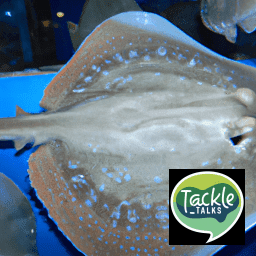The Barndoor Skate, scientifically known as Dipturus laevis, belongs to the Rajidae family. It is a large species of skate fish found primarily in the western Atlantic Ocean.
Conservation Status
The current conservation status of the Barndoor Skate is listed as “Least Concern” according to the most recent assessment. Despite past overfishing concerns, conservation efforts, including restrictions on fishing and habitat restoration, have helped the population to steadily recover.
Statistics
| Statistical Category | Average | Range |
|---|---|---|
| Length | 76 cm | 40-150 cm |
| Weight | 6 kg | 1-9 kg |
| Life Span | Up to 18 years | |
Distribution
Barndoor Skates can be found in the western part of the Atlantic Ocean. They mostly inhabit regions around the United States, Canada, and down to the Caribbean. There’s no significant migration pattern recorded for this species.
Habitats
Preferring a marine environment, Barndoor Skates can typically be found in sandy or muddy sea bottoms within the depth of 24 to 400 meters. The species can adapt to a variety of temperatures, ranging from 2°C to 20°C.
When and Where to See
Though Barndoor Skates can generally be spotted year-round, they are in most abundance during Spring and Summer months. They can often be sighted near the ocean floor during the day.
Best Fishing Locations
Fishing for Barndoor Skates can be most productive in the following locations:
1. Georges Bank, USA
2. Southern New England, USA
3. Gulf of Maine, USA
4. Grand Banks, Canada
5. Scotian Shelf, Canada
6. Northeast United States Continental shelf
7. Gulf of St. Lawrence, Canada
8. North Carolina coast, USA
9. Virginia coast, USA
10. Gulf of Mexico, USA
If specific locations aren’t known, look for muddy or sandy bottoms in the ocean at depths between 24 and 400 meters.
How to Catch
While there isn’t a preferred bait or lure specifically for catching Barndoor Skates, they can often be caught using pieces of shellfish or worms. Techniques such as bottom fishing work best since they typically reside at the ocean floor. The most successful fishing season is typically during the Spring and Summer months.
Identification Guide
Barndoor Skates are distinguished by their flat bodies with wing-like pectoral fins, triangular-shaped snouts, and a dark-colored backside that ranges from reddish-brown to gray. Their underside is pale or white in color. Their long tails also have three distinctive rows of sharp thorns along the back.
Culinary
Barndoor Skate is often enjoyed for its unique texture and flavor. It has a sweet taste with a moderately firm texture. It can be baked, fried, or grilled and pairs well with a variety of cuisine styles. The wings of the skate are the most commonly consumed part of the fish. Its meat is rich in protein, low in fat, and high in vitamin B12.
Additional Information
Barndoor Skates are primarily benthivorous, feeding on a range of bottom-dwelling creatures such as crustaceans, mollusks, and small fishes. They lay eggs in rectangular capsules which have unique points at the corners known as “mermaid’s purses”. Among their significant threats are larger marine creatures like sharks. Human activities, like overfishing and habitat destruction, also pose a considerable threat.
References and Further Reading
For detailed information on the Barndoor Skate, readers are encouraged to explore scientific journals and marine biology publications. In particular, the following sources are recommended: Florida Museum of Natural History, National Oceanic and Atmospheric Administration (NOAA), and Fisheries and Oceans Canada

